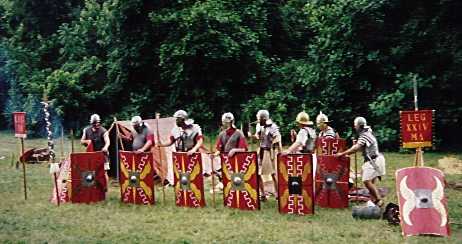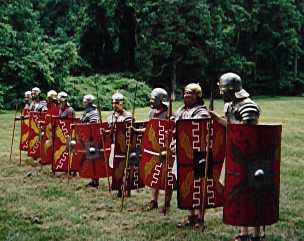Scutum
(from old site - needs work) |
(pics) |
||
| Line 1: | Line 1: | ||
| − | [[Image: | + | [[Image:RD_line05.jpg|right|frame]] |
| + | |||
| + | A ''scuta'' is a shield. | ||
| + | |||
There are many options for scutum size, shape, and materials. The "standard" specifications are given below in bold, followed by options and explanations. At the end is a summary of historical evidence for the scutum. | There are many options for scutum size, shape, and materials. The "standard" specifications are given below in bold, followed by options and explanations. At the end is a summary of historical evidence for the scutum. | ||
| Line 7: | Line 10: | ||
A press is made of three or more pieces cut from 2" lumber as shown, laid in a row to the approximate length of the shield. (They can be joined together with scrap lumber, or fixed to a plywood base, etc.) Glue the two layers of the shield together with hide or wood glue and immediately place one edge in the notches of the press; then use drywall screws and an electric screwdriver to begin screwing the wood down, working from the notches and placing screws approximately 3" apart. (Simply bending the free end down may crack the wood.) Allow the glue to dry overnight (some may ooze out), then remove the screws and trim the edges of the wood if necessary. | A press is made of three or more pieces cut from 2" lumber as shown, laid in a row to the approximate length of the shield. (They can be joined together with scrap lumber, or fixed to a plywood base, etc.) Glue the two layers of the shield together with hide or wood glue and immediately place one edge in the notches of the press; then use drywall screws and an electric screwdriver to begin screwing the wood down, working from the notches and placing screws approximately 3" apart. (Simply bending the free end down may crack the wood.) Allow the glue to dry overnight (some may ooze out), then remove the screws and trim the edges of the wood if necessary. | ||
| − | [[Image:Rd_line04.jpg]] | + | |
| + | [[Image:Rd_line04.jpg|right|frame]] | ||
| + | |||
Cut a circular handhole in the exact center, approximately 5" in diameter. | Cut a circular handhole in the exact center, approximately 5" in diameter. | ||
Revision as of 17:25, 18 September 2006
A scuta is a shield.
There are many options for scutum size, shape, and materials. The "standard" specifications are given below in bold, followed by options and explanations. At the end is a summary of historical evidence for the scutum.
Rectangular or curve-sided, 37"-42" tall (about from shoulder to top of knee), 24-33" wide, corners rounded to approximately 1 1/4" radius.
Plywood core 1/4" to 3/8" thick, made from two layers of wood; e.g. 1/8" - 3/16" plywood wall paneling; glued together in a curve. This is best done in a press.
A press is made of three or more pieces cut from 2" lumber as shown, laid in a row to the approximate length of the shield. (They can be joined together with scrap lumber, or fixed to a plywood base, etc.) Glue the two layers of the shield together with hide or wood glue and immediately place one edge in the notches of the press; then use drywall screws and an electric screwdriver to begin screwing the wood down, working from the notches and placing screws approximately 3" apart. (Simply bending the free end down may crack the wood.) Allow the glue to dry overnight (some may ooze out), then remove the screws and trim the edges of the wood if necessary.
Cut a circular handhole in the exact center, approximately 5" in diameter.
Make a horizontal handgrip of hardwood, cut to match the curve of the shield, approximately 18"-24" long, 3/4" wide, 3/4" thick behind the hole, approximately 1/2" thick for the rest. Glue in place and reinforce with 2-4 nails; drill holes first, then put through from front and clench securely at the back. Handgrip can also be a steel strip approximately 1/8" thick, riveted with nails; wrap the grip with leather.
Back bracing: either wood 1/2" - 3/4" wide, approximately 1/4" thick, flat or half-round; or a steel strip approximately 1/8" thick. Arrangement as shown (around the edges of the shield with one horizontal and one vertical brace in the middle), approximately 3" from the edges.
Cover front and back with leather, linen, felt, canvas, etc. Leather should be maximum 3 oz. thickness, vegetable-tanned or rawhide (chrome-tanned or waxed leathers may be difficult to paint). Glue coverings on with hide or wood glue. (If two or more pieces are used, seams can be covered by applied arrows or spines.)
Paint front and back with Red Devil Latex Enamel "Crimson" (1 pint), or similar color of other paint, or dye to similar color before gluing facing to wood. Trace emblem using Legion's stencil (if available). Wings should be Yellow Oxide or Yellow Ochre, or a lighter yellow; spines, lightning bolts, and arrows may be the same as the wings, or a lighter yellow, or white. Black outlines and details are best done last. The various parts of the emblem may optionally be linen or thin leather, either dyed with painted details, or entirely painted, and sewn to the facing before it is glued to the shield. They can even be thin brass, with the white parts either tinned or made of thin steel; nail on with brass brads after covering is in place. (These options allow the leather facing to be dyed and waterproofed with oil, etc. before being glued in place.)
Brass Rim, approximately 0.015" thick. corners can be made from 6" lengths of 1/2" to 3/4" tube; anneal, pack with sand, and bend with spring-type pipe bender; cut open with dremel tool or snips. Each side (or top/bottom) can be either a single piece of strip or tube, or pieced (with small overlaps for security) if necessary. (0.015" strips can be bent into shape by hand, even directly onto the shield edge, without annealing.) Nail rim with brass escutcheon pins or similar steel brads, clenched at the back. Optionally, leather or rawhide rim; 2" wide strips stitched on (drill small holes through the wood first, 1/4" to 1/2" apart, 1/4" to 1/2" in from the edge). Cut corner pieces to match the curve and avoid puckering. Leather rim is painted or dyed red, black, or yellow.
line of soldiersBoss: 18 to 12-ga. brass or steel, approximately 5" diameter dome on rectangular base 8" square up to 10"x11". To make a boss, cut metal to desired size and bend to match the curve of the shield. Cut a 5" diameter hole in a piece of 2"x8" lumber, and dish the metal into the hole with a large ball-peen hammer. Start at the center and work outwards in a slow spiral, then repeat, until the dome is at least 1 1/2" deep. Metal can be annealed for easier working. Watch the curge of the base; it will tend to curl irregularly. After dishing, place a large hammer head or similar object inside the boss and go over the outside with a small hammer to plannish out the worst of the dents. The boss may have punched, engraved, or inlaid decoration.
Rivet the boss in place with 4-8 bronze or steel nails or bolts, using square washers or nuts at the back. Line up the holes carefully to go through the back bracing; this will reinforce the handle.
Optional corner "L's"; brass or steel approximately 0.015" thich, 4"x4", 3/4" wide. They are aligned with the corners of the back bracing and are riveted on with bronze or steel nails, 3 or 5 each. (Lightning bolt decorations may be shortened to fit.)
Optional neck strap; heavy leather, 1 1/4" to 2" wide. Secure the ends to the boss rivets or directly to the grip. The exact form and use of the neck strap is debated; modern experiments are contradictory! The Fayum shield had iron rings on the back, and an iron shield handle from Newstead has loops, possibly for strap attachments. Historical Evidence
Polybius' description, mid 2nd Century BC. Curved, layered wood, covered with leather and linen. Top and bottom rimmed with metal, iron boss. 4' tall, 2 1/2' wide (in the early oval shape).
Fayum scutum, 1st Century BC. Curved oval, 52" x 25". Three layers of birch strips, totalling approximately 1/2" thick at the middle, 3/8" at the edges. Wooden "spine" boss, horizontal hand grip. Front and back covered with felt which is folded over edges and stitched through the wood. Weight 22 pounds.
Dura Europas scutum, circa 250 AD (possibly earlier). Curved rectangle approximately 41" x 33", quite deep. Three layers of wood strips totalling 1/4" thick overall. Wood back bracing, "half-round", middle horizontal brace thickened to form grip. Front and back covered with thin leather, and front has an additional layer of linen. Leather or hide rim stitched on. Whole shield painted red, and front heavily decorated with intricate painted designs and figures. Boss is missing, but had a rectangular base. Total weight approximately 12 pounds. A second scutum from Dura Europas, less well-preserved, measured 37" x 25".
Doncaster shield, 1st Century AD. Flat rectangle with slightly convex top and bottom edges, roughly 2' x 4'. Three layers of oak and elder, covered with hide. Bronze boss is dome on cross-shaped base with large ornate arms. Four rows of nails in X pattern. Iron handle wrapped with leather. Weight 20+ pounds.
Tyne boss, 1st Century AD. Bronze; hemispherical dome on a rectangular base 10" x 10 1/2", curved to a radius of approximately 18". Decorated with punched and engraved designs. Iron bosses with hexagonal bases also known.
Bronze rim pieces, found on numerous 1st Century sites. Fairly thin metal (less than 1/32"), so their purpose was cosmetic rather than defensive. Dimensions show that the scutum edge was approximately 1/4" thick.
Other finds. Thin metal stars, moons, lightning bolts; thin cast bronze motifs with flat backs and rivet holes; fragments of leather from shield facings or covers with stitch holes in decorative patterns.
There are numerous depictions of the scutum from the 1st Century, but some details are still unclear. It is most often rectangular, but sometimes has curved sides. Sometimes corner "L's" are visible; those and other features could have been applied trim or painted. From the few colored illustrations that survive, it seems that shields were often red.
Master Index > English > Nova Roma
Master Index > English > Nova Roma
Master Index > Maintenance Categories > Pages to be deleted
Master Index > Maintenance Categories > Pages to be deleted > Via Romana > Roman Clothing and Equipment
Master Index > Maintenance Categories > Pages to be deleted > Via Romana > Roman Clothing and Equipment > Roman Armour

